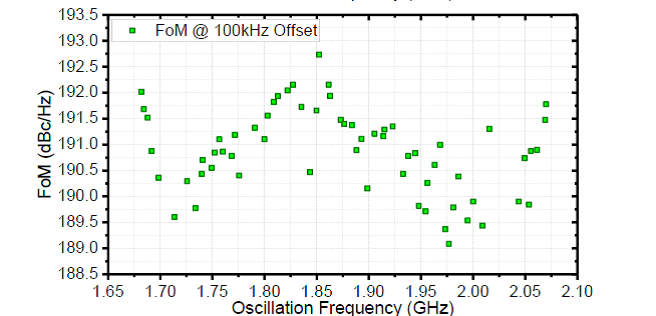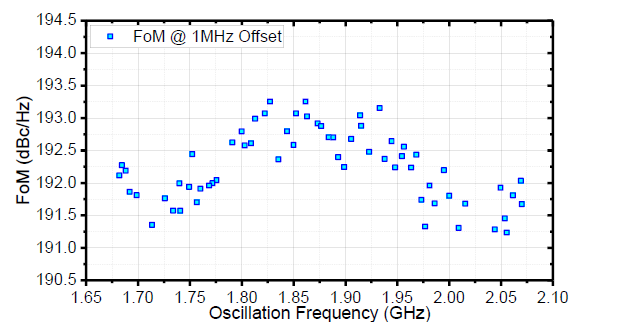Researchers at Georgia Institute of Technology have developed a transformer-based inverted complementary cross-coupled VCO topology wherein the source nodes of the cross-coupled pairs are inherently separated. It achieves a superior phase noise performance, with significantly suppressed flicker noise up-conversion without any start-up degradation. At 1.86 GHz oscillation frequency, the VCO showed a -87.3/-109.1/- 130.2dBc/Hz phase noise at 10k/ 100k/1MHz offsets while dissipating 1.14mA from a 1.5V supply (Figure 1). The VCO consistently achieved a 20.8% tuning range from 1.68 to 2.07 GHz, resulting in a maximum FoMT of 199.6 dBc/Hz. Compared to the recently published CMOS VCOs, the current technology demonstrates state-of-the-art phase noise and FoM from 10KHz to 1 MHz offsets and the lowest 1/f3 noise corners over a wide tuning range.
- Inherently separate device source nodes for the cross-coupled devices with no compromise on the VCO startup condition.
- The new topology ensures both low phase noise and low DC power.
- Superior close-in 1/f3 phase noise.
- Superior supply pulling performance.
- Low power and wide frequency tuning bandwidth.
- High-performance commercial wireless communication.
- High-performance defense wireless communication links and broadband radar systems for surveillance.
Modern wireless systems demand fully integrated CMOS voltage-control oscillators (VCOs) with low phase noise, low power consumption, and a wide tuning range. The Class-C VCO achieves an efficient dc-to-fundamental conversion and thus a high figure-of-merit (FoM), but often with a compromised start-up condition. Harmonic waveform shaping can reduce flicker noise up-conversion. However, it requires complex tank design with dedicated harmonic impedance tuning, limiting its achievable performance over a wide frequency range and its widespread adoption in practice due to compromised oscillation voltage swing or a degraded start-up margin. Therefore, aggressively improving the CMOS VCO phase noise while balancing other performance metrics still remains as a challenging design task.


